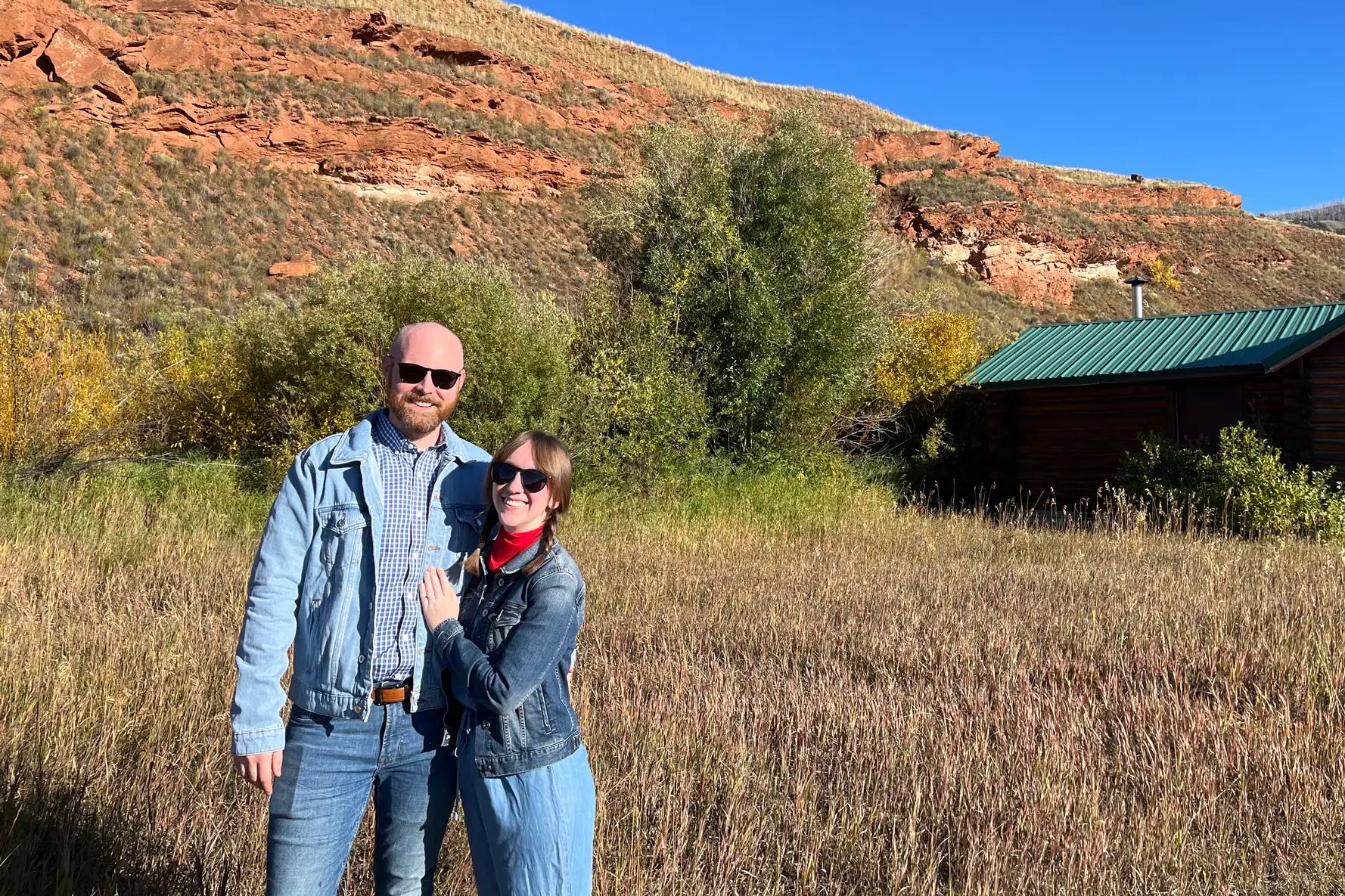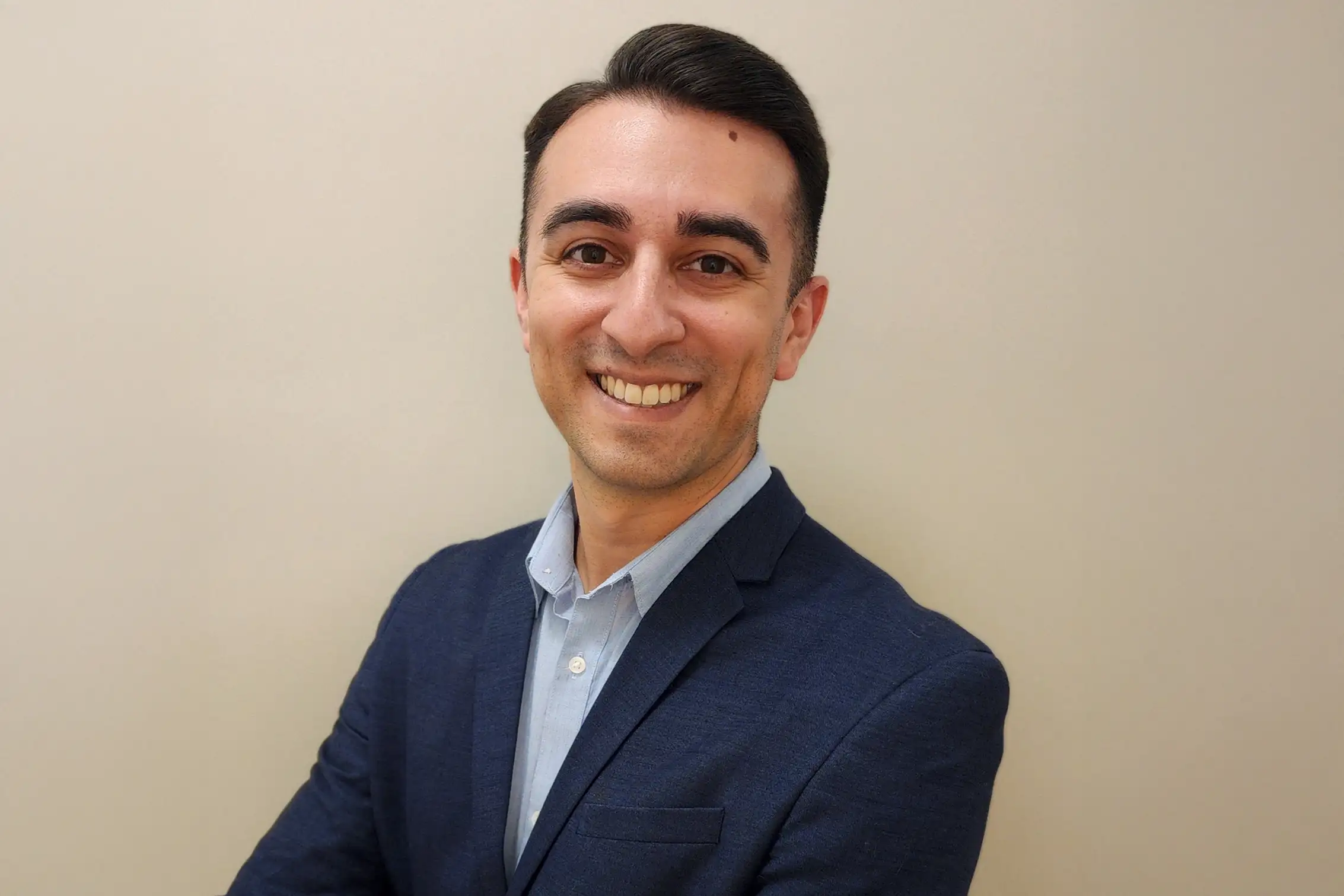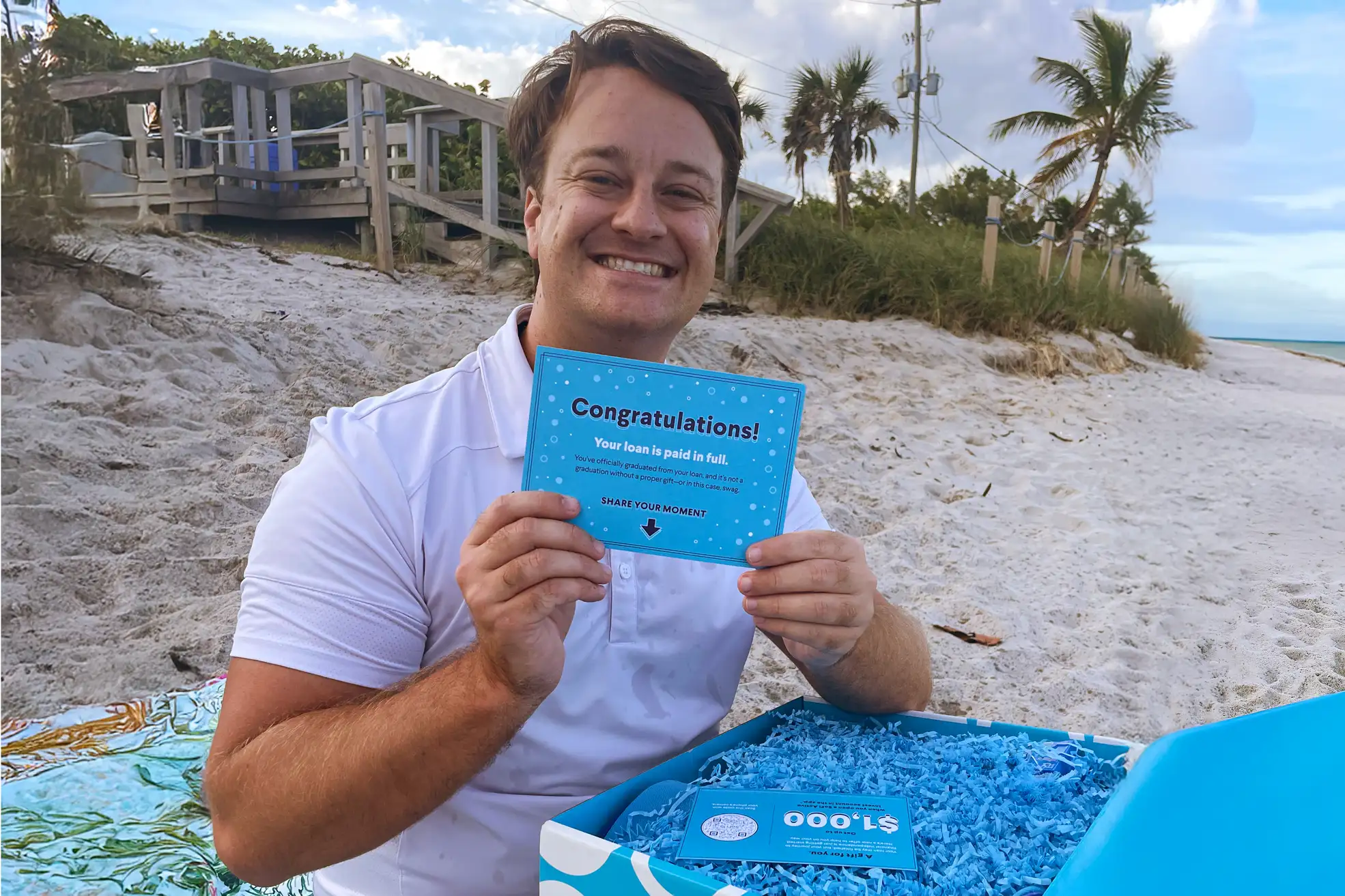Entering adulthood and the job market for the first time with student loan debt can be stressful. But watching that debt balloon with interest as you navigate through your 20s, 30s, 40s and beyond can feel completely overwhelming.
And yet that’s the experience for many borrowers. While the government’s “standard” repayment plan is 10 years long, many borrowers are in plans that extend their terms up to 20 years or longer. If unmanaged, the burden of student loans can weigh on your potential to build an emergency fund or jumpstart retirement savings. It can delay your ability to buy a home or reach other financial goals.
But it doesn’t have to, especially if you focus on paying your loans off swiftly, allowing you to accrue less interest than peers who only make minimum payments.
Here’s an inside look at how four borrowers paid off their student loans quickly.
Avoid ‘lifestyle inflation’

Erin and her husband, Mike.
Courtesy of Erin Adams Chanler
Who are they?
Erin Adams Chanler, 35, based in Portland, Maine
How much student loan debt did they borrow?
- Private student loans: $87,667.07 via five loans with interest rates ranging from 7.59% to 12.63%
- Federal student loans: $13,161 via four loans with interest rates ranging from 3.15% to 5.75%
- Total debt at graduation: $100,828.07
How long did it take them to pay it off?
6.5 years
Erin Adams Chanler grew up in a blue-collar family and was raised with very limited wisdom on how to manage her personal finances.
“There was a lot of emphasis on if you work hard, you can do anything,” Adams Chanler says. “But there was not as much emphasis on how that might be paid for.”
So when she attended an expensive liberal arts college, she graduated in 2012 with roughly $100,000 in debt. A postgraduate move to San Francisco — one of the priciest places to live in the U.S. — for a non-profit job that paid her $40,000 didn’t help with paying off her loans. But Adams Chanler says the trick to paying off her debt quickly was to avoid “lifestyle inflation,” which is when your spending increases because your income does. She got a new job in tech with a salary that continued to increase – $70,000 when she first got the job and $130,000 by the time her debt was gone. But she stayed living in a “less cool, less nice neighborhood” where she was sharing a bedroom and had a long commute. She cooked at home and limited her traveling, which she loves to do. At one point, she was throwing an average of more than $3,600 per month at her student loan debt.
At times it felt isolating. Her friends who were also working in tech were moving into better apartments, going out to eat and booking flights.
“It was hard to see the light at the end of the tunnel,” Adams Chanler said. That is, until she paid off her largest loan, which was also the one with the highest interest. “It felt so good.”
In hindsight, she says she wishes she had been less ashamed about her debt and more vulnerable about it. She says she thinks people in her life would have been more understanding than she feared at the time, and explaining that she was working toward paying off her loans would have made turning down costly plans more easier. But in the end, she got there — and much faster than it often takes people to pay off $100,000.
“It’s really heavy holding that much debt especially when you’re young and just starting out,” Adams Chanler said. “I am actively grateful all the time that I don’t have that anymore.”
Use the snowball method

Who are they?
Erik Vargas, 32, based in Memphis, Tennessee
How much student loan debt did they borrow?
- Federal student loans: $29,000 via nine loans capped at 6% interest rate due to the Servicemembers Civil Relief Act
- Total debt at graduation: $29,000
How long did it take them to pay it off?
3 years of solid work (8 years total)
When Erik Vargas decided to get married and combine his finances with his wife Amanda, the pair agreed on the first financial goal of their marriage: pay off all their debt as fast as they could. While Vargas was still paying off his car, most of their debt was student loans.
Vargas had been making the minimum payments on his $29,000 in student debt since he graduated roughly five years before they got married. Amanda had about $47,000 in student loans herself, so together, they implemented a strict budget and the snowball method. The strategy entails making minimum payments on all your debts while putting as much extra money as possible toward your smallest debt until it disappears. You then use what you were paying on your smallest debt and tackle the second-smallest debt, and continue the process until you’re debt-free. It’s a popular method because it can help you see some fast results compared to other paydown strategies.
Vargas, who worked for the Navy at the time, had nine separate loans while Amanda had two larger ones, so they were able to start seeing their progress quickly. They also had the advantage of being in lockdown due to the COVID-19 pandemic and benefitted from the pandemic pause on federal loans that put interest at 0%. Traveling, eating out with friends and most of their usual activities were off limits, and they were able to put the money they would have spent on fun toward their loans.
They identified their recurring bills — internet, rent, appliances and their cell phones — then allotted a certain amount of money for fun and the rest went to debt payments. (They still use this method, though now the money that would have gone toward loans goes into savings for a house). The stimulus checks that they received from the federal government during the pandemic went straight toward paying off their loans. If they wanted to do something specific, like a ski trip, they would save for it while making sure they were also making progress on their student loans.
“The last two big loans that we had were probably the hardest to get through,” Vargas says. The couple was able to tackle several smaller loans every few weeks, but then they got bigger and bigger. “It just became a slog at the end.”
But in 2023, Vargas and his wife finally hit the debt-free milestone — and they even appeared on popular personal finance guru Dave Ramsey’s radio show to celebrate it.
Find the positive in your lifestyle changes
Who are they?
Evan Louey-Dacus, 23, based out of New York City
How much student loan debt did they borrow?
- Federal student loans: $11,000 (two loans with interest rates of 3.48% and 4.74%)
- Total debt at graduation: $11,000
How long did it take them to pay it off?
1 year and 1 month
When Evan Louey-Dacus graduated from college with $11,000 in student loans and moved into his own place, his new job fell through. He found himself with rent to pay and no income, and he accrued interest on his student loans for around four months before he made his first payment.
But at the end of 2023, he landed a new job in marketing for corporate events and started aggressively paying down his loans, earmarking a quarter of his paychecks — and sometimes up to a third — every month for debt.
“Debt dictates dependency,” Louey-Dacus says. “If I had student debt it meant that I was dependent on the government in some way and I don’t want to be any more dependent on the government than I absolutely have to.”
His father is the child of Chinese immigrants and both his parents are entrepreneurs, so Louey-Dacus says he was raised in an environment that emphasized frugality. That mindset motivated him to pay down his debt quickly.
“I had to humble myself and get used to the fact that my life was not going to be super extravagant or built on the schedule that I had in mind until that loan was paid down,” Louey-Dacus says. For instance, he set the heat on a timer so it would only run at night and not rack up a huge bill. But he also found the positive in having to make such a lifestyle shift: a love for cooking.
Louey-Dacus says he stopped eating out and almost exclusively made his own meals at home. While he had cooked prior to leaving his parents’ home and having student debt, it wasn’t something that had been tied to his identity before.
“Now that I had to do it on a regular basis to affordably feed myself, I really started to enjoy it,” he says. “I didn’t consider myself a cook, but now I do — and I don’t think I would have done that as quickly if I didn’t have student debt to pay down.”
That love for cooking paid off. Louey-Dacus just scheduled his last debt payment.
Consider side gigs and refinancing

Courtesy of Brett Holzhauer
Who are they?
Brett Holzhauer, 31, based in Fort Lauderdale, Florida
How much student loan debt did they borrow?
- Private student loans: $72,669 with an interest rate of around 7%
- Total debt at graduation: $72,669
How long did it take them to pay it off?
7 years
When Brett Holzhauer graduated from college with roughly $73,000 in private student loan debt, he was looking for balance. He wanted to pay down his debt quickly, but he didn’t want to completely upend his lifestyle.
He turned to side gigs to generate extra income he could pay toward his debt. Holzhauer delivered groceries via Instacart, resold items online and picked up freelance writing projects . He sometimes made as much as $5,000 a month.
But Holzhauer says another key to finally paying off his debt was refinancing, which essentially replaces your loan with a new one that (ideally) comes with a smaller interest rate.
“It’s not the balance that’s the evil, it’s the interest rate,” Holzhauer says.
His first refinance was in 2016 with SoFi, and he was able to lower his interest rate from around 7% to 5.34% (coincidentally, he later briefly worked for SoFi). He then refinanced three more times over a roughly three-year period, getting his loan down to 2.2%. He later unofficially “refinanced” by having his then father-in-law pay off his student loans that he would pay back without interest. When he had to pay that back ahead of schedule after he and his wife divorced, he took out a personal line of credit with a 2.25% interest rate to pay off the remainder of his debt.
“I just started seeing the light at the end of the tunnel become brighter and brighter and was like ‘Wait a second, I can kind of play this game and really get [the rate] down,’” Holzhauer says. “I was extremely proactive. I was checking every couple months to see if there was any way I could keep whittling this thing down.”
In the end, he did. Holzhauer, who now writes about small business full time for Biz2Credit, an online financing platform for small business, has been free of his student debt for a couple years. He paid off his last loans just before he turned 29, reaching the goal of having no student loan debt by his 30th birthday that he’d set at graduation.
Editor’s note: While SoFi is the sponsor of this story, Money reported and wrote this story, including the section with a former SoFi employee, without any influence from the company.
More from Money:
How to Pay Off Student Loans Fast
9 Million Student Loan Borrowers Will Soon Take a ‘Significant’ Credit Score Hit
5 Tips to Get the Lowest Interest Rate When Refinancing Your Student Loans




